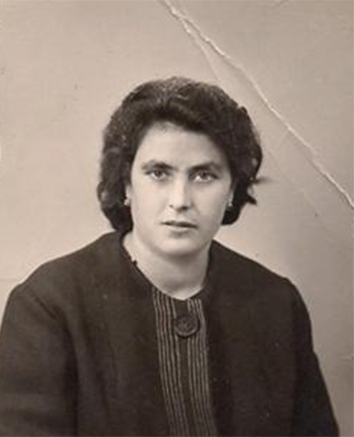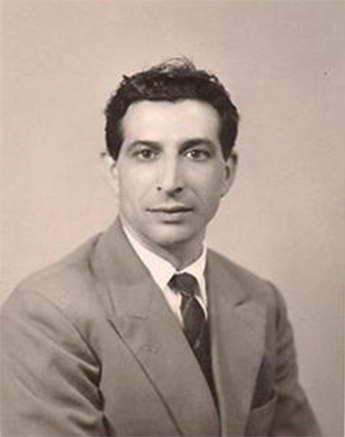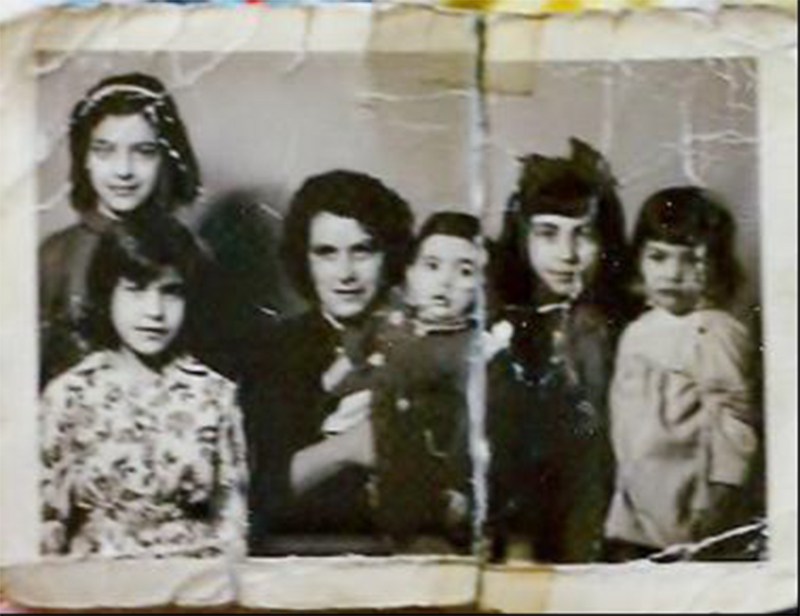Sobey Wall of Honour
Column
168
Row
25
IN ITALY
Maria Barbieri (Cugliari) and Giuseppe Barbieri had five young girls aged 17 months – 11 years old when they disembarked at Pier 21 Halifax in July of 1965. A sixth child and 50 years later, below is the account of their journey.
Maria Barbieri (Cugliari) and Giuseppe Barbieri were both born in Sant’ Onofrio, Calabria, Italy – a small farming community. They were childhood sweethearts in Italy at a time when women and men were chaperoned, unmarried women were never left alone with a man, admiration of the opposite sex was from afar in church and family gatherings, and marriages were arranged and sanctioned by the brides’ and groom’s parents. If you have seen the movie “Fiddler on the Roof” this movie would be an excellent comparison to the marriage rituals in small town Italy in the early 1950’s. With rare, vivid blue eyes and a beautiful demeanor, Maria had many suitors who expressed their interest to marry to her parents, but she refused to marry any of them as she was in love with Giuseppe. Thankfully Maria’s parents were more liberal than most and did not insist that Maria marry those suitors. Giuseppe finally mustered the courage to express his interest to marry Maria to his parents. Giuseppe’s parents then approached Maria’s parents and all involved approved the marriage. Giuseppe and Maria got married within 2 months of the betrothal.
In the early 50s, Maria’s uncle (who more like a bother to her) married Giuseppe’s sister, who decided to immigrate to Argentina after their first child was born. Having just gotten married, Maria and Giuseppe decided that they would join their uncle and sister once they’d saved up the money.
In 1954, Giuseppe and Maria welcomed their first daughter Annunziata. Just two years later Maria became pregnant with her second child. Due to particular circumstances that affected Maria, an abrupt stop was made, for the young family’s imminent immigration to Argentina.
Around this time, Maria’s brother Maurizio decided to immigrate to Canada with his wife Caterina. Many people in the town had made the move to Toronto by this time, and the calls to leave were persistent.
While continuing with the process and hopes to immigrate to the Americas Maria gave birth to Maria 14 months after Fortunata was born.
Maria and Giuseppe, in Sant’ Onofrio with their 3 healthy daughters, continue to and discuss the hopes and dream of a better life, immigrating to the Americas. Maria becomes pregnant for the fourth time. Another little girl is gifted to them, who they name Giuseppina. Giuseppina appears to be healthy, but dies within 9 days of her birth. Maria and Giuseppe are devastated by the death of their child.
Maria and Giuseppe are faced with a dilemma:
Giuseppe's beloved sister and Maria's uncle have been in Argentina for a few years, calling them to join them. Maria's brother Maurizio – with whom she was very close – was leaving for Canada. This was a difficult division of family. To decide where to go was difficult, since all were very close to each other, shared many wonderful childhood memories and difficult times.
Argentina's economy at that time was doing very well, and the weather was pleasant. Canada, they were told, was frigid cold but one could become rich, since there was plenty of work. Maria and Giuseppe agonized on where to go. Both still in their late twenties, adventurous and with youth on their side, they applied for immigration to both countries. Giuseppe and Maria agree to be fair to each other that whichever country accepts their immigration first that will be where they go. While waiting for the immigration visa for either Canada or Argentina, Maria becomes pregnant for the fifth time. Giuseppina is born, named after her sister.
The couple was then faced with four daughters, with no notice from either country. Southern Italy was becoming very desperate. The effects of the war were still being felt, there was no work, and no future for the people of Southern Italy. If not abroad, many of the town folks found work in Northern Italy. Giuseppe and Maria decided that a move was necessary.
Giuseppe left alone for Torino to find work and an apartment for the family. It was very difficult for Giuseppe to leave Maria and his girls. As well, since Giuseppe's father was in America for most of his youth, he understood the meaning of not having a father present and he did not want this for his children.
Giuseppe was able to successfully find work in the Fiat plant. Soon he found an apartment in a not-so-great area of Torino, but it was good enough to reunite his family. The family was united again and begun to prosper in the North. At first the Southern Italian family felt like outsiders in the North, but because there were so many people from the South that had also made the move, they began to build a strong network and community. Giuseppe received a promotion to line supervisor, which allowed the family to move to a better area and apartment in Torino. Along with the financial prosperity, the family grows once again with the birth of their fifth child – another girl named Silvana. The name Silvana is not a common southern name; Maria chose it from a calendar.
Maria and Giuseppe described their time in Torino with a smile. To this day, Torino remains one of Maria’s happiest memories. They were at the height of their youth. Five beautiful daughters, a good job and apartment, but this was not enough. Their adventurous sprit and the prospect of joining friends and family who had gone to America was still a consideration. America now had more importance for them: a better education for the girls and a better life for the family. So many they knew told stories on how much better off they were in America.
Maria and Giuseppe had not heard from either the Canadian or Argentinian government until one day, 3 years after arriving in Torino, they received a letter from the Canadian government. Their immigration was approved. Well, Canada it was. Two days later a letter from the Argentinian government came and also approved them. But in keeping with their pact, Canada was the choice.
ON GOING TO CANADA
The family’s eldest daughter, Annunziata, was 10 years old when her parents Maria and Giuseppe decided to make the move to Canada. She remembers them having sold all the furniture in their little Torino apartment, packing up their trunk, and making a final trip to Calabria to say their goodbyes to their grandparents. Just a few days later, the family left Sant’Onofrio for Napoli where they boarded the big ship that would lead them to Pier 21. Annunziata remembers peering over the side of the ship and seeing a crowd of faces waving to loved ones and crying. The second eldest daughter, Fortunata, also remembers beginning the long 8 day journey on the ship, but was generally excited to be meeting the uncles, aunts and cousins that would greet them in Toronto. The journey was hard on everyone as Maria and the girls got seasick and Giuseppe, anxious and frustrated, took care of them. On the final day of the boat journey upon arrival in Halifax, the girls were dressed in special dresses Maria had purchased for their arrival. Annunziata remembers arriving in Halifax and hearing all the passengers yelling out to each other “Siamo arrivate!!!”
At Pier 21, the family waited for a long time, eagerly tracking down their baggage and attempting to communicate with various English-speaking officials. Finally the family boarded the train to Toronto, which took 2 days. Fortunata, having slept for nearly the entire train ride, remembers arriving disoriented at Toronto’s union station. They were finally reunited with their family at the station and drove over to their house. When they arrived, Fortunata remembers the whole family gazing up at the typical Toronto row houses with the peaked roofs, and Giuseppe asked if they keep pigeons up there. He said “If I were alone right now, I would return home.” That was the first instance of the family experiencing culture shock, to see such a difference in architecture in this new city. They entered the house and Annunziata remembers that it was absolutely filled with people – paesane and all the cugini, and everyone excitedly gave each other big hugs and kisses. She remembers looking at her father and mother with their tired faces and they said, “Bella, siamo qua.”
Soon Maria and Giuseppe became comfortable with their surroundings, and the girls stumbled through school, learning their curriculum and the English language simultaneously. After those first three months, they found jobs, bought their first home, bought their first car, and started building the foundation of their newly enriched life. For good measure they also added a sixth daughter, Antonina, to the thriving family. As the years progressed, Giuseppe changed his mind from that first impression of wanting to turn back to thinking, “I’ll never go back; I know this was the right choice for my family.” Fifth daughter Silvana relays the courage Maria and Giuseppe needed to delve into the unknown. She – and the rest of the sisters – admires her parents’ spirit, determination, courage and persistent hard work to improve their children’s well being, and the strength to have moved to a country that rewarded people with these virtues.
The family became Canadian citizens with pride. In July 2015, the Barbieri family celebrated the 50 year anniversary of their trip through Pier 21.



